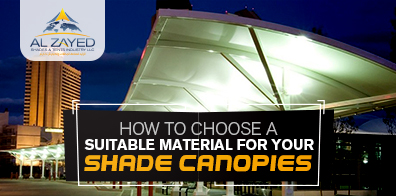
If you are thinking of investing in installing a shade canopy, it is highly indispensable to invest in a top-notch product to receive high ROI in the long run. The choice of material has a great bearing on the quality and durability of shade canopies. Therefore, when it comes to choosing a material for your shade canopy, you need to consider prudently, since an inferior shade canopy might be cheap, but won’t last you long.
As a specialist in providing stellar shade canopies, I can tell you all there is to know about the best materials for shade canopies. Here are all the important factors that you need to keep in mind when selecting a viable material for your shade canopy, so that you invest in a superior quality product that is long-lasting and offers years of top-notch service.
The suitability of a shade canopy to your needs is the first factor that should be kept in mind when selecting the right material. The material of your choosing should be highly suitable for a canopy shade fabric so that it provides utmost protection. While you have a plethora of material choices, woven PVC, knitted polyethylene, and HDPE shade cloths are high viable fabrics for your shade canopies. Not only are these fabrics extremely durable and long-lasting, they can withstand the harsh and scorching UAE heat spells. A shade canopy fabricated from one of these materials can have a life of up to 15 years.
A lot of shade fabric materials available in the market these days are not exactly waterproof, even if they claim otherwise. This holds true for knitted polyethylene, woven PVC, and HDPE fabrics as well. Such fabrics lack rain protection since they are porous in nature. However, even if a lot of shade canopy suppliers leverage these fabrics, they can add a waterproof coating to the material to make them suitable to your needs. Once your fabric has been rendered water-proof, you can delve in the outdoors anytime of the year and enjoy all-weather protection under the shade canopy.
When installing shade canopies, you would be prudent to choose materials that allow natural light transmission and let ample sunlight through. Fabrics that allow significant transmission of light would do you well in this regard. For this, you need to select fabrics that are light in color. However, what you need to keep in mind is that light colors reflect and scatter more UV radiation, so be sure to leverage materials for shade fabrics that are specially treated for UV protection.
If you want to keep the detrimental effects of UV rays at bay, you need to make sure that the material of your choice offers adequate UVR protection. The UPF rating of a shade fabric gauges its ability to block out UV rays. Fabrics with a low UPF rating are usually cheap and don’t offer much protection from weather elements. If you want to garner maximum protection from the sun’s UVR, it’s better to capitalize on a top-notch fabric with a viable UPF rating, suitable to your needs. Specially treated fabrics can further improve the UPF rating of ay fabric.
Since the maintenance of a shade canopy can be cost-intensive, it’s better to choose materials that are low maintenance and don’t incur much overheads. You don’t want to be continually dealing with the regular cleaning and maintenance of any structure that you have erected. Since some shade fabrics are specially treated to thwart the growth of mold, they can serve best for rainy areas. Furthermore, the fabric of your choice shouldn’t discolor easily or allow dirt and grime to accumulate over the surface.
A lot of people deck out their patios and other outdoor areas with potted plants and flowers. If you are using a fabric like canvas for your shade canopy, the lack of sunlight which can stream through could have negative repercussions for your greens. A knitted shade fabric serves well in this regard since it lets in enough sunlight to let plants thrive, while providing sufficient shade at the same time. Also, since knitted fabrics are not exactly water proof, they even allow water to pass through for your plants.